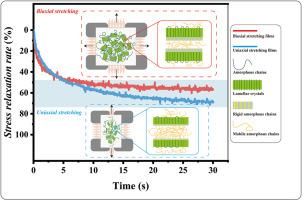拉伸聚乳酸薄膜在约束退火过程中的原位应力松弛行为及结构演化研究
IF 4.5
2区 化学
Q2 POLYMER SCIENCE
引用次数: 0
摘要
聚乳酸(PLA)薄膜在热加工过程中如何控制应力松弛,影响其尺寸稳定性和性能。本研究阐明了苯基膦酸锌(PPZn)和硫酸钙晶须(CSW)增强PLA薄膜在单轴(UCS)或双轴(BS)拉伸约束退火过程中的应力松弛机制。通过系统地比较PLA/PPZn/CSW薄膜在控制比率(2.0-5.0)下拉伸,原位测量显示BS薄膜的应力松弛明显慢于UCS薄膜,特别是在较高比率下。综合表征(x射线散射,傅里叶变换红外光谱)将这种差异归因于双轴取向诱导的分子三维网络限制,证明了玻璃化转变温度升高15°C和非晶相刚性增强。结构演化跟踪证实了自增强的晶体-非晶态界面障碍,在最大拉伸下,片层厚度增加了1.7 nm,结晶度从28%上升到35%。使用连续和离散松弛时间谱的广义麦克斯韦模型进行定量分析,为研究粘弹性行为和网络稳定性提供了新的见解。这些发现建立了明确的结构-性能关系,解决了应力松弛控制中的关键挑战,为优化PLA薄膜性能提供了实用策略,用于先进包装和柔性电子应用。本文章由计算机程序翻译,如有差异,请以英文原文为准。

Investigation of in-situ Stress Relaxation Behavior and Structural Evolution in Stretched Polylactic Acid Films during Constrained Annealing
Polylactic acid (PLA) films face challenges in controlling stress relaxation during thermal processing, impacting dimensional stability and performance. This study elucidates the stress relaxation mechanisms of PLA films reinforced with zinc phenylphosphonate (PPZn) and calcium sulfate whisker (CSW) during constrained annealing following uniaxial (UCS) or biaxial (BS) stretching. By systematically comparing PLA/PPZn/CSW films stretched at controlled ratios (2.0-5.0), in-situ measurements reveal significantly slower stress relaxation in BS films compared to UCS films, especially at higher ratios. Comprehensive characterizations (X-ray scattering, Fourier transform infrared spectroscopy) attribute this divergence to biaxial orientation-induced molecular three-dimensional network confinement, evidenced by a 15°C elevation in glass transition temperature and enhanced amorphous phase rigidity. Structural evolution tracking confirms self-reinforcing crystal-amorphous interfacial barriers, with lamellar thickness increasing by 1.7 nm and crystallinity rising from 28% to 35% under maximum stretching. Quantitative analysis using generalized Maxwell modeling with continuous and discrete relaxation time spectra provides new insights into the viscoelastic behavior and network stability. These findings establish a clear structure-property relationship addressing critical challenges in stress relaxation control, offering a practical strategy to optimize PLA film performance for advanced packaging and flexible electronics applications.
求助全文
通过发布文献求助,成功后即可免费获取论文全文。
去求助
来源期刊

Polymer
化学-高分子科学
CiteScore
7.90
自引率
8.70%
发文量
959
审稿时长
32 days
期刊介绍:
Polymer is an interdisciplinary journal dedicated to publishing innovative and significant advances in Polymer Physics, Chemistry and Technology. We welcome submissions on polymer hybrids, nanocomposites, characterisation and self-assembly. Polymer also publishes work on the technological application of polymers in energy and optoelectronics.
The main scope is covered but not limited to the following core areas:
Polymer Materials
Nanocomposites and hybrid nanomaterials
Polymer blends, films, fibres, networks and porous materials
Physical Characterization
Characterisation, modelling and simulation* of molecular and materials properties in bulk, solution, and thin films
Polymer Engineering
Advanced multiscale processing methods
Polymer Synthesis, Modification and Self-assembly
Including designer polymer architectures, mechanisms and kinetics, and supramolecular polymerization
Technological Applications
Polymers for energy generation and storage
Polymer membranes for separation technology
Polymers for opto- and microelectronics.
 求助内容:
求助内容: 应助结果提醒方式:
应助结果提醒方式:


